冀教版八年级英语下册教案Unit 3 第5课时
冀教版八年级英语下Unit5一等奖说课稿
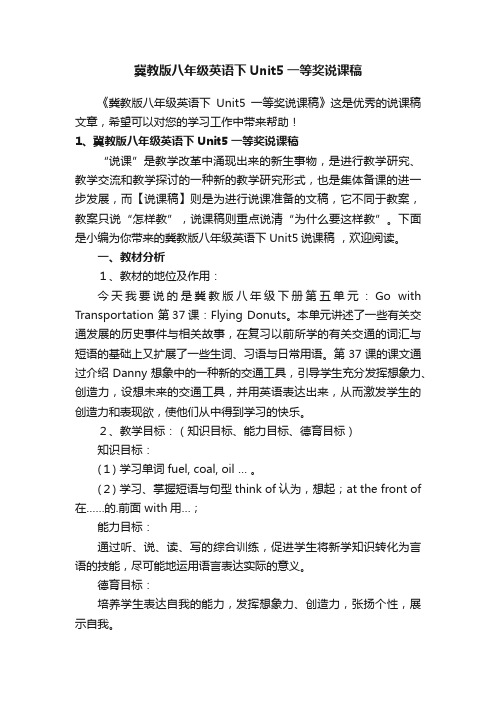
冀教版八年级英语下Unit5一等奖说课稿《冀教版八年级英语下Unit5一等奖说课稿》这是优秀的说课稿文章,希望可以对您的学习工作中带来帮助!1、冀教版八年级英语下Unit5一等奖说课稿“说课”是教学改革中涌现出来的新生事物,是进行教学研究、教学交流和教学探讨的一种新的教学研究形式,也是集体备课的进一步发展,而【说课稿】则是为进行说课准备的文稿,它不同于教案,教案只说“怎样教”,说课稿则重点说清“为什么要这样教”。
下面是小编为你带来的冀教版八年级英语下Unit5说课稿,欢迎阅读。
一、教材分析1、教材的地位及作用:今天我要说的是冀教版八年级下册第五单元:Go with Transportation 第37课:Flying Donuts。
本单元讲述了一些有关交通发展的历史事件与相关故事,在复习以前所学的有关交通的词汇与短语的基础上又扩展了一些生词、习语与日常用语。
第37课的课文通过介绍Danny想象中的一种新的交通工具,引导学生充分发挥想象力、创造力,设想未来的交通工具,并用英语表达出来,从而激发学生的创造力和表现欲,使他们从中得到学习的快乐。
2、教学目标:(知识目标、能力目标、德育目标)知识目标:(1) 学习单词fuel, coal, oil … 。
(2) 学习、掌握短语与句型think of认为,想起;at the front of 在……的.前面 with用…;能力目标:通过听、说、读、写的综合训练,促进学生将新学知识转化为言语的技能,尽可能地运用语言表达实际的意义。
德育目标:培养学生表达自我的能力,发挥想象力、创造力,张扬个性,展示自我。
确立教学目标的依据:根据英语教学大纲规定,通过听、说、读、写的训练,使学生获得英语基础知识与为交际初步运用英语的能力,激发学生的学习兴趣,为进一步学习打好初步的基础。
此外,根据我国国情与外语教学大纲的要求,现阶段外语教学的素质教育主要包括思想素质教育、目的语素质教育、潜在外语能力的培养、非智力因素的培养等四方面。
冀教版初中英语八年级下册Unit 3 Animals Are Our Friendsword教案 (2)
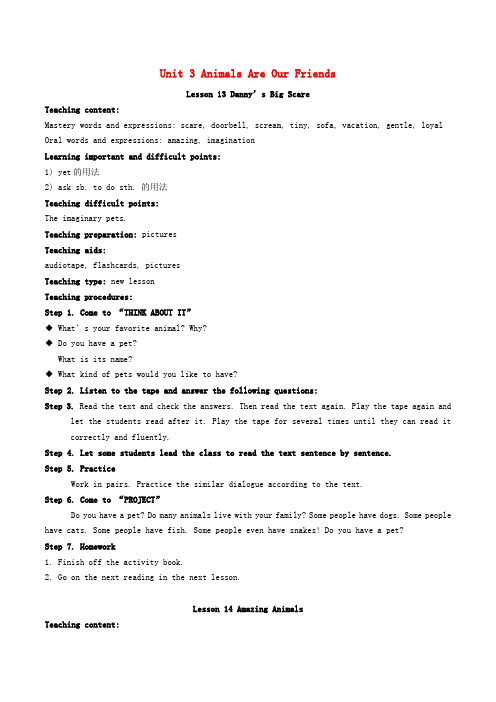
Unit 3 Animals Are Our FriendsLesson 13 Danny’s Big ScareTeaching content:Mastery words and expressions: scare, doorbell, scream, tiny, sofa, vacation, gentle, loyal Oral words and expressions: amazing, imaginationLearning important and difficult points:1) yet的用法2) ask sb. to do sth. 的用法Teaching difficult points:The imaginary pets.Teaching preparation: picturesTeaching aids:audiotape, flashcards, picturesTeaching type: new lessonTeaching procedures:Step 1. Come to “THINK ABOUT IT”◆ What’s your favorite animal? Why?◆ Do you have a pet?What is its name?◆ What kind of pets would you like to have?Step 2. Listen to the tape and answer the following questions:Step 3. Read the text and check the answers. Then read the text again. Play the tape again and let the students read after it. Play the tape for several times until they can read it correctly and fluently.Step 4. Let some students lead the class to read the text sentence by sentence.Step 5. PracticeWork in pairs. Practice the similar dialogue according to the text.Step 6. Come to “PROJECT”Do you have a pet? Do many animals live with your family? Some people have dogs. Some people have cats. Some people have fish. Some people even have snakes! Do you have a pet?Step 7. Homework1. Finish off the activity book.2. Go on the next reading in the next lesson.Lesson 14 Amazing AnimalsTeaching content:Oral words and expressions:long-eared, jerboa, mouse, kiwi, lay, eggplant, shake, flap, avoid Learning important and difficult points1) remind的用法2) lay的用法Teaching preparation: picturesTeaching aids:audiotape, flashcards, picturesType of lesson: new lessonTeaching procedures:Step 1. ReviewStep 2. Come to “THINK ABOUT IT.”◆ Can you name some animals you have never seen before?◆ What animals do you think are amazing? Why?Step 3. Read the text silently and ask the students to answer the following questions:Step 4. Play the tape and let the students read after it. Pause after every line, and ask the students to repeat.Step 5. Let some students read the text in class and the others listen to see if they have any mistakes. Can they find and correct the mistakes?Step 6. Let the students rewrite the story and read it to the class.Step 7. Discuss the reading with the students. Use as much English as possible. Ask questions to make it easier for students to participate.Step 8. HomeworkWould you like to have a pet?Why or why not?Write a paragraph.Lesson 15 The Zoo Is OpenTeaching content:Mastery words and expressions: danger, dangerous, mainly, bamboo, giraffeLearning important and difficult points:1.take photos2.nearly的用法Teaching preparation: picturesType of lesson: new lessonTeaching procedures:Step 1. Show some pictures of animals to the class. Ask the students:What animals do you like best?What animals can you see in the zoo?Step 2. Come to “THINK ABOUT IT.”▲ Have you ever been to the zoo?▲ What animals do you think are dangerous? Why?▲ What rules should we obey at the zoo?Step 3. Read the text.Step 4. PracticeStep 5. Read the text in roles. The teacher walks in the classroom while they are reading. Help them if necessary.Step 6. Let some students come to the front and act the dialogue out.Step 7. HomeworkPrepare the dialogue in group of three in “Let’s Do It”, and act it the next class.Lesson 16 The Bear Escaped!Teaching content:Mastery words and expressions: escape, fierce, protect, foolLearning important and difficult points:1.escape的用法2.if的用法3.wake upTeaching preparation: picturesTeaching aids:audiotape, flashcards, picturesType of lesson: new lessonTeaching procedures:Step 1. Free talkStep 2. Come to “THINK ABOUT IT.”★ When is April Fools’ Day?★ What do people do on that day?★ Have you ever played a trick on a friend? What did you do?Step 3. Listen to the tape and answer the questionsStep 4. Read the text and check the answers. Then let the students read it loudly in class. Aftera while, ask the students to act it out in front of the class.Step 5. Come to “LET’S DO IT”◆What do you thin k of the idea of April Fools’ Day?◆ Have you ever played a trick on someone? Share a trick with you partner.◆What do you think “ white lie” means?Step 7. HomeworkDo you know any other interesting foreign festivals?Write them down, and share with your partner next class.Lesson 17 Save the TigersTeaching content:Mastery words and expressions: century, fur, symbol, courage, brave, chain, balance, reason, disappear, kill, cut, decreaseLearning important and difficult points:1) the number of2) balance的用法3) danger的用法Teaching preparations: picturesTeaching aids:audiotape, flashcards, picturesTeaching procedures:Step 1. ReviewStep 2. Come to “THINK ABOUT IT.”Where can you usually see a tiger?Do you think tigers need our help? Why or why not?Step 3. Listen to the tape and repeat after it. Play the tape for several until they can read it correctly and fluently.Step 4. Let some students act the dialogue out in front of the class.Step 8. HomeworkWork in groups and discuss some ways we can protect animals. Write down your ideas.Lesson 18 Friendship Between AnimalsTeaching content:Mastery words and expressions: friendship, rhino, skin, warn, insect, relationship, survive, mzee, hippo, tortoise, truly, boundaryLearning important and difficult points:1) use的用法2) warn的用法Teaching preparation: picturesTeaching aids:audiotape, flashcards, picturesType of lesson: new lessonTeaching procedures:Step 1. Come to “THINK ABOUT IT”◆Do you think there is friendship between animals?◆ What different animals have you seen living well together?Step 2. Listen to the tape and let some students retell the main idea about the text. If they can’t do well, don’t publish them. Encourage them and say: “I know it is very difficult for you. It’s also difficult for me. Let’s face the problem together.”Step 3. Read the text silently and answer the questionsStep 4. ExerciseStep 5. HomeworkWhat will you do if you go to the zoo?Do you know anything that we cannot do in the zoo? Why?Think about it, and write a short paragraph.。
冀教版八年级英语(下)Unit5教案

冀教版八年级英语(下)Unit5教案Unit 5 Go With Transportation!一、本单元语言知识(1)本单元应掌握的词汇:anywhere, licence, type, ship, sail, hometown, seldom,rapid, capain, rail, invent, wheel, engineer, railway, passenger, iron, during, speed, even, certainly, invention,present, round, dangerous, factory, humorous, wing , drive, village,countryside, ride, park, oil, coal, smooth, second, space, sound,dirty, electric(2)本单元接触的词汇:transportation, inventor, steam, engine, steam engine, locomotive, explode, distance, per, magnetic, jet, jet engine, presentation, North America, creatice, imagination, highway, afar,fuel, hoverboard, skateboard, float, transporter, show, spaceship,pedal,electricity(3)词组和句型on foot, t ake a train/ship/plane, get in/ on /of f…,(at)a top speed of, as long as, No parking, in a hury, all the time, go through, present…to…, sount likeCan /could I /you …? Certainly/Sure/Of course! You’d better not…,It takes…to…(4)功能意念:1.Giving Advice/Order给出建议/命令2.Possiblity and Impossibility可能和不可能(5) 语法Modal Verbs情态动词二、语言技能听:1.听录音时能够有目的的获取所需关键信息 2,以词或词组的形式简单记录所获取的信息。
冀教版英语八下Unit 3《Aimals Are Our Friends》单元说课稿
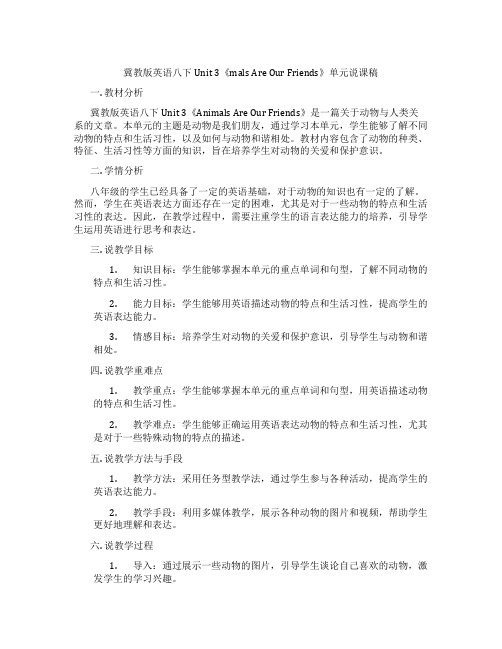
冀教版英语八下Unit 3《mals Are Our Friends》单元说课稿一. 教材分析冀教版英语八下Unit 3《Animals Are Our Friends》是一篇关于动物与人类关系的文章。
本单元的主题是动物是我们朋友,通过学习本单元,学生能够了解不同动物的特点和生活习性,以及如何与动物和谐相处。
教材内容包含了动物的种类、特征、生活习性等方面的知识,旨在培养学生对动物的关爱和保护意识。
二. 学情分析八年级的学生已经具备了一定的英语基础,对于动物的知识也有一定的了解。
然而,学生在英语表达方面还存在一定的困难,尤其是对于一些动物的特点和生活习性的表达。
因此,在教学过程中,需要注重学生的语言表达能力的培养,引导学生运用英语进行思考和表达。
三. 说教学目标1.知识目标:学生能够掌握本单元的重点单词和句型,了解不同动物的特点和生活习性。
2.能力目标:学生能够用英语描述动物的特点和生活习性,提高学生的英语表达能力。
3.情感目标:培养学生对动物的关爱和保护意识,引导学生与动物和谐相处。
四. 说教学重难点1.教学重点:学生能够掌握本单元的重点单词和句型,用英语描述动物的特点和生活习性。
2.教学难点:学生能够正确运用英语表达动物的特点和生活习性,尤其是对于一些特殊动物的特点的描述。
五. 说教学方法与手段1.教学方法:采用任务型教学法,通过学生参与各种活动,提高学生的英语表达能力。
2.教学手段:利用多媒体教学,展示各种动物的图片和视频,帮助学生更好地理解和表达。
六. 说教学过程1.导入:通过展示一些动物的图片,引导学生谈论自己喜欢的动物,激发学生的学习兴趣。
2.新课呈现:教师引导学生通过观察图片和阅读文章,了解不同动物的特点和生活习性。
3.课堂活动:学生分组讨论,用英语描述所学的动物的特点和生活习性。
4.语言练习:学生进行角色扮演,模拟与动物的对话,提高学生的英语表达能力。
5.巩固活动:学生完成相关的练习题,巩固所学知识。
冀教版八年级英语下册Unit3AnimalsAreOurFriends优质教案(2)
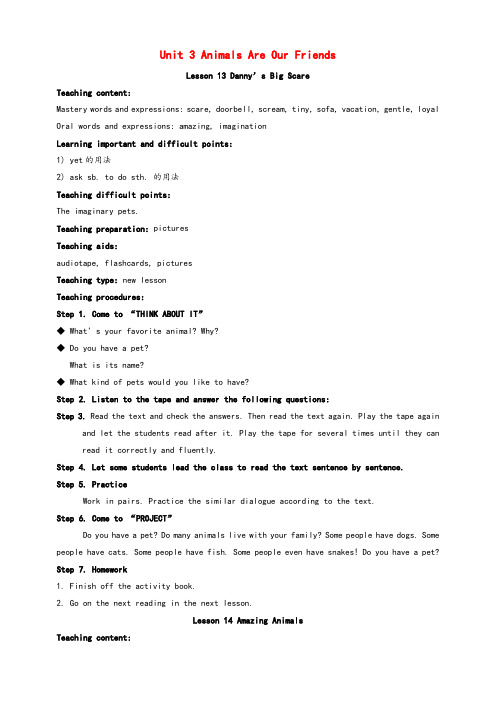
Unit 3 Animals Are Our FriendsLesson 13 Danny’s Big ScareTeaching content:Mastery words and expressions: scare, doorbell, scream, tiny, sofa, vacation, gentle, loyal Oral words and expressions: amazing, imaginationLearning important and difficult points:1) yet的用法2) ask sb. to do sth. 的用法Teaching difficult points:The imaginary pets.Teaching preparation: picturesTeaching aids:audiotape, flashcards, picturesTeaching type: new lessonTeaching procedures:Step 1. Come to “THINK ABOUT IT”◆ What’s your favorite animal? Why?◆ Do you have a pet?What is its name?◆ What kind of pets would you like to have?Step 2. Listen to the tape and answer the following questions:Step 3. Read the text and check the answers. Then read the text again. Play the tape again and let the students read after it. Play the tape for several times until they can read it correctly and fluently.Step 4. Let some students lead the class to read the text sentence by sentence.Step 5. PracticeWork in pairs. Practice the similar dialogue according to the text.Step 6. Come to “PROJECT”Do you have a pet? Do many animals live with your family? Some people have dogs. Some people have cats. Some people have fish. Some people even have snakes! Do you have a pet? Step 7. Homework1. Finish off the activity book.2. Go on the next reading in the next lesson.Lesson 14 Amazing AnimalsTeaching content:Oral words and expressions:long-eared, jerboa, mouse, kiwi, lay, eggplant, shake, flap, avoidLearning important and difficult points1) remind的用法2) lay的用法Teaching preparation: picturesTeaching aids:audiotape, flashcards, picturesType of lesson: new lessonTeaching procedures:Step 1. ReviewStep 2. Come to “THINK ABOUT IT.”◆ Can you name some animals you have never seen before?◆ What animals do you think are amazing? Why?Step 3. Read the text silently and ask the students to answer the following questions: Step 4. Play the tape and let the students read after it. Pause after every line, and ask the students to repeat.Step 5. Let some students read the text in class and the others listen to see if they have any mistakes. Can they find and correct the mistakes?Step 6. Let the students rewrite the story and read it to the class.Step 7.Discuss the reading with the students. Use as much English as possible. Ask questions to make it easier for students to participate.Step 8. HomeworkWould you like to have a pet?Why or why not?Write a paragraph.Lesson 15 The Zoo Is OpenTeaching content:Mastery words and expressions: danger, dangerous, mainly, bamboo, giraffeLearning important and difficult points:1.take photos2.nearly的用法Teaching preparation: picturesType of lesson: new lessonTeaching procedures:Step 1. Show some pictures of animals to the class. Ask the students:What animals do you like best?What animals can you see in the zoo?Step 2. Come to “THINK ABOUT IT.”▲ Have you ever been to the zoo?▲ What animals do you think are dangerous? Why?▲ What rules should we obey at the zoo?Step 3. Read the text.Step 4. PracticeStep 5. Read the text in roles. The teacher walks in the classroom while they are reading.Help them if necessary.Step 6. Let some students come to the front and act the dialogue out.Step 7. HomeworkPrepare the dialogue in group of three in “Let’s Do It”, and act it the next class.Lesson 16 The Bear Escaped!Teaching content:Mastery words and expressions: escape, fierce, protect, foolLearning important and difficult points:1.escape的用法2.if的用法3.wake upTeaching preparation: picturesTeaching aids:audiotape, flashcards, picturesType of lesson: new lessonTeaching procedures:Step 1. Free talkStep 2. Come to “THINK ABOUT IT.”★ When is April Fools’ Day?★ What do people do on that day?★ Have you ever played a trick on a friend? What did you do?Step 3. Listen to the tape and answer the questionsStep 4. Read the text and check the answers. Then let the students read it loudly in class.After a while, ask the students to act it out in front of the class.Step 5. Come to “LET’S DO IT”◆What do you think of the idea of April Fools’ Day?◆ Have you ever played a trick on someone? Share a trick with you partner.◆What do you think “ white lie” means?Step 7. HomeworkDo you know any other interesting foreign festivals?Write them down, and share with your partner next class.Lesson 17 Save the TigersTeaching content:Mastery words and expressions: century, fur, symbol, courage, brave, chain, balance, reason, disappear, kill, cut, decreaseLearning important and difficult points:1) the number of2) balance的用法3) danger的用法Teaching preparations: picturesTeaching aids:audiotape, flashcards, picturesTeaching procedures:Step 1. ReviewStep 2. Come to “THINK ABOUT IT.”Where can you usually see a tiger?Do you think tigers need our help? Why or why not?Step 3. Listen to the tape and repeat after it. Play the tape for several until they can read it correctly and fluently.Step 4. Let some students act the dialogue out in front of the class.Step 8. HomeworkWork in groups and discuss some ways we can protect animals. Write down your ideas.Lesson 18 Friendship Between AnimalsTeaching content:Mastery words and expressions: friendship, rhino, skin, warn, insect, relationship, survive, mzee, hippo, tortoise, truly, boundaryLearning important and difficult points:1) use的用法2) warn的用法Teaching preparation: picturesTeaching aids:audiotape, flashcards, picturesType of lesson: new lessonTeaching procedures:Step 1. Come to “THINK ABOUT IT”◆Do you think there is friendship between animals?◆ What different animals have you seen living well together?Step 2. Listen to the tape and let some students retell the main idea about the text. If they can’t do well, don’t publish them. Encourage them and say: “I know it is very difficult for you. It’s also difficult for me. Let’s face the problem together.”Step 3. Read the text silently and answer the questionsStep 4. ExerciseStep 5. HomeworkWhat will you do if you go to the zoo?Do you know anything that we cannot do in the zoo? Why?Think about it, and write a short paragraph.。
冀教版英语八年级下册Unit 3:Lesson 17 Save the Tigers. 课程教学设计

教学设计Unit 3 Lesson 17: Save the Tigers【教材分析】本课属于冀教版《英语》八年级下册Unit 3 Animals Are Our Friends中的第5课,主要围绕animals这一主题展开各种教学活动。
本单元旨在创设一个愉快的交流环境和通过听,说,读,写来培养学生综合运用这些知识的能力,再通过有限的课堂实践活动,让学生用英语表达关于动物的情况。
本课是这个单元的第五课时,分别通过描述救助老虎的一个组织和老虎对于环境的重要性以及老虎面临灭绝的危险,最终为了号召人们保护老虎保护野生动物。
【学情分析】我所教授的是初二学生(以中等生为主)。
学生对这个主题感兴趣,好奇心强,求知欲旺盛,但是对于英语既感到好奇又是很担忧,很希望得到老师的肯定。
因此,在教学中,我尽量让他们参与到教学中来,用尽可能丰富的课堂活动来为学生创造更多说英语的机会。
通过学生之间的合作学习,降低他们学习的难度,使他们不断体会到成功的喜悦。
一、设计思路1.指导思想:《中小学英语课程标准》指出:英语教学中应体现交际性,要结合学生的年龄特点和生活实际,创设交际情景,通过大量的语言实践,使学生获得综合运用英语和语言技能进行交际,以及写作的能力。
针对初中英语新教材容量大的特点,为了使教学面向全体学生,依据本课的课程理念,采用自主阅读为辅,课堂小组合作讨论为主的学习模式,充分发挥学生学习的主观能动性。
2.教学目标知识目标:使学生掌握关于保护动物的词汇,正确的掌握和使用不定代词。
技能目标:使学生培养语言学习能力,尤其是阅读写作能力。
情感目标:使学生热爱动物,保护动物,爱护环境;。
3.教学重点与难点教学重点:(1)掌握一些与互保护动物有关的词汇。
(2)提高学生的阅读和口语能力。
教学难点:帮助学生理解如何跳读、略读、细读课文。
并把所学应用到日常交流中。
三、教学过程Step 1: Lead in.Lead in with a picture: food chain→The tiger is at the top of the food chain.Q: Does the tiger have enemies?Show some pictures about tigers in danger.Q: Who is the tiger's biggest enemy?→Human beingsQ: What should we do?→Save the Tigers设计意图:层层递进带领学生进入本课主题,通过提出问题的方式引发学生思考,自然过渡引出文章标题。
冀教版英语八下Unit 3《Aimals Are Our Friends》单元教学设计
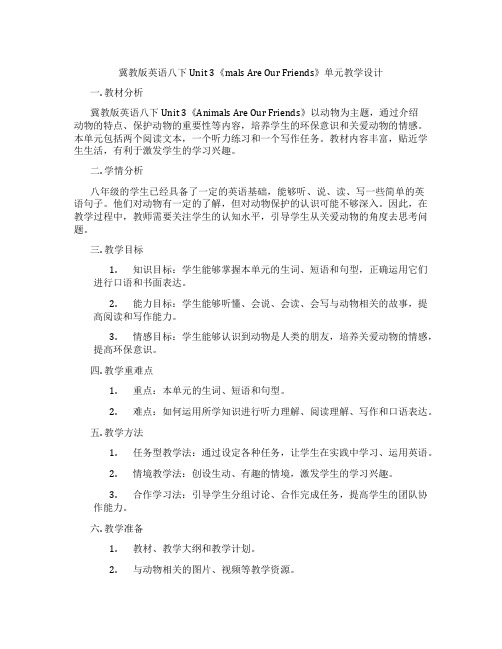
冀教版英语八下Unit 3《mals Are Our Friends》单元教学设计一. 教材分析冀教版英语八下Unit 3《Animals Are Our Friends》以动物为主题,通过介绍动物的特点、保护动物的重要性等内容,培养学生的环保意识和关爱动物的情感。
本单元包括两个阅读文本,一个听力练习和一个写作任务。
教材内容丰富,贴近学生生活,有利于激发学生的学习兴趣。
二. 学情分析八年级的学生已经具备了一定的英语基础,能够听、说、读、写一些简单的英语句子。
他们对动物有一定的了解,但对动物保护的认识可能不够深入。
因此,在教学过程中,教师需要关注学生的认知水平,引导学生从关爱动物的角度去思考问题。
三. 教学目标1.知识目标:学生能够掌握本单元的生词、短语和句型,正确运用它们进行口语和书面表达。
2.能力目标:学生能够听懂、会说、会读、会写与动物相关的故事,提高阅读和写作能力。
3.情感目标:学生能够认识到动物是人类的朋友,培养关爱动物的情感,提高环保意识。
四. 教学重难点1.重点:本单元的生词、短语和句型。
2.难点:如何运用所学知识进行听力理解、阅读理解、写作和口语表达。
五. 教学方法1.任务型教学法:通过设定各种任务,让学生在实践中学习、运用英语。
2.情境教学法:创设生动、有趣的情境,激发学生的学习兴趣。
3.合作学习法:引导学生分组讨论、合作完成任务,提高学生的团队协作能力。
六. 教学准备1.教材、教学大纲和教学计划。
2.与动物相关的图片、视频等教学资源。
3.录音机、投影仪等教学设备。
4.作业本、测试卷等教学资料。
七. 教学过程1.导入(5分钟)利用图片、视频等资源,引导学生谈论自己喜欢的动物,激发学生的学习兴趣。
2.呈现(10分钟)介绍本节课的主题,展示本节课的生词、短语和句型。
通过生动、有趣的方式,让学生感知和理解新知识。
3.操练(15分钟)采用任务型教学法,让学生在各种情境中练习新知识。
例如,分组讨论动物的特点,用英语进行描述;角色扮演,模拟与动物相关的场景等。
冀教版八年级英语下册Unit3单元教学设计

(二)过程与方法
在本章节的教学过程中,教师将采用以下方法引导学生学习:
1.采用任务型教学法,设计真实语境,让学生在实际情境中练习一般过去时。
2.利用多媒体教学资源,如图片、视频等,帮助学生形象地理解和记忆生词和语法。
3.通过小组合作、讨论、展示等形式,培养学生主动参与、积极思考的学习习惯。
(三)学生小组讨论
1.教师将学生分成小组,每组分配一个话题,如:周末活动、学校运动会等,要求学生用一般过去时描述话题中的活动。
2.学生在小组内进行讨论,互相交流想法,共同完成句子构建。
3.每个小组派一名代表进行展示,其他小组成员认真倾听,学习他人的优点,互相借鉴。
4.教师对每个小组的表现进行点评,给予鼓励和指导,提高学生的自信心。
3.语法练习:
-完成课后练习册中的一般过去时专项练习题,包括填空、选择、改写句子等。
-注意:在完成练习时,仔细思考,确保答案正确。
4.阅读理解:
-阅读一篇关于过去发生的故事或事件的英语文章,并回答相关问题。
-要求:理解文章内容,准确把握一般过去时的运用。
5.创作练习:
-分组进行创作练习,每组编写一个发生在过去的小故事,并表演出来。
1.创设情境,激发兴趣:
-利用多媒体展示与学生生活相关的场景,如:周末活动、假期旅行等,引导学生用一般过去时描述过去发生的事情。
-设计角色扮演活动,让学生在模拟真实语境中练习一般过去时,提高他们的口语表达能力。
2.分层次教学,关注个体差异:
-针对不同学生的学习程度,设计难易程度不同的练习题,使每个学生都能在原有基础上得到提高。
冀教版八年级英语下册Unit3单元教学设计
冀教版新课标八年级英语下册教案

冀教版新课标八年级英语下册教案英语教案的教学设计直接决定了是否能够上好一节英语课,下面是小编为大家精心整理的冀教版新课标八年级英语下册教案,仅供参考。
冀教版新课标八年级英语下册教案范文一、教材依据: Unit1: Spring is coming!Lesson 4: The Spring City二、教材分析:本单元围绕春天展开中心话题,描述了春天的天气和户外活动,加强了同学们对异国文化的了解和对祖国文化的热爱提高了学生学习英语的兴趣。
三、学情分析:现在初二的学生对于英语学习应该具有一定的基础和方法,但我们所处在山区农村中学,从初一才开始接触英语,所以对于英语的学习还没有掌握好的方法,学生在学习中还存在许多问题。
对于所学句子还不能在平时灵活运用,所以课堂中老师应尽可能多的运用多种教学方法来引导学生学习。
四、教学目标:1、知识与技能目标掌握本课的单词,了解春城——昆明的美景,并能在听听录音时,有目的的获取所需关键信息。
2、过程与方法目标通过听录音,自读及小组合作的方法学习课文,让学生热爱春天,热爱大自然!3、情感态度与价值观能通过谈论春天的天气,温度,空气和植物,让学生了解春天,热爱春天,了解异国文化和祖国文化的差异,拥抱大自然!五、教学重难点1、单词2、短语及语法六、教法与学法小组讨论、合作探究、教师指导七、课型新授八、教学过程Step 1.Lead-inA warming-upA sayingStep 2.pictures show and new words, then, listeningShow some pictures about spring and learn the new words by playing a game, the do the listening about the text and answer one simple question.What is the spring city?It’s Kunming.Step 3.ReadingAsk several students to read the text and pay attention to the new words, the students read it again, and discuss together about the four questions in “Let’s Do It.part1”Step 4. ListeningDo the listening in “Let’s Do It!”part2, listen to it twice, and then invite some students to answer them.Step 5.DiscussingDivide the class into small groups; write the following words on the blackboard:Air /weather/ plants/ and outdoor activities.Step nguage points1. feel like /sound like / smell like / taste likefeel like doing sth.2. because and because ofBecause +句子Because of + n./pron./doing3. hundreds of /基数词+单位名词(hundred /thousand/million/billion)4. think of =consider5. all over the world =around the world6. all year round7. plenty of=a lot of =lots of8. long for= look forward toStep 6.Homework1、Write a short passage about spring in your hometown2、Preview Lesson 5Step 7.Summary:Review the text is very important. The students know what they will take to the class, what is useful to the study. Let them to talk about The Spring City. --- Its air, weather, plants and the outdoor activities in spring.九、板书设计:Lesson 4: The Spring CityAir weather plants and the outdoor activities十、教学反思:本节课在前几节课学习的基础上进一步来学习春天,通过运用多媒体向学生展示了春天的景色。
最新冀教版八年级下册英语精品教案设计Unit 3
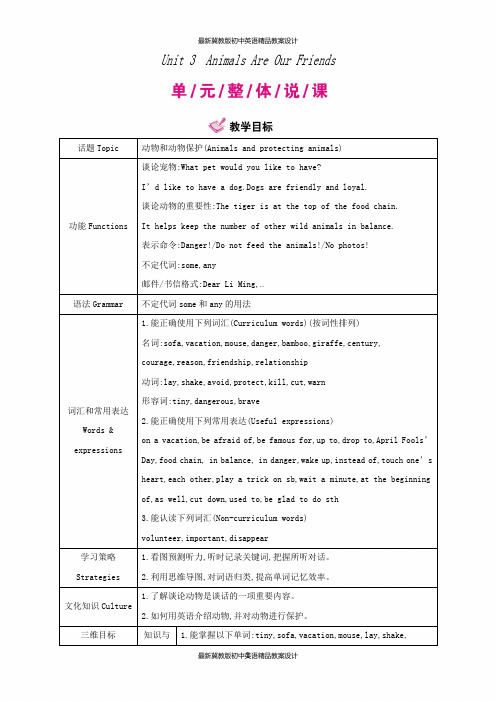
Unit 3 Animals Are Our Friends话题Topic 动物和动物保护(Animals and protecting animals)功能Functions 谈论宠物:What pet would you like to have?I’d like to have a dog.Dogs are friendly and loyal.谈论动物的重要性:The tiger is at the top of the food chain. It helps keep the number of other wild animals in balance. 表示命令:Danger!/Do not feed the animals!/No photos!不定代词:some,any邮件/书信格式:Dear Li Ming,…语法Grammar 不定代词some和any的用法词汇和常用表达Words & expressions 1.能正确使用下列词汇(Curriculum words)(按词性排列)名词:sofa,vacation,mouse,danger,bamboo,giraffe,century,courage,reason,friendship,relationship动词:lay,shake,avoid,protect,kill,cut,warn形容词:tiny,dangerous,brave2.能正确使用下列常用表达(Useful expressions)on a vacation,be afraid of,be famous for,up to,drop to,April Fools’Day,food chain, in balance, in danger,wake up,instead of,touch one’s heart,each other,play a trick on sb,wait a minute,at the beginning of,as well,cut down,used to,be glad to do sth3.能认读下列词汇(Non-curriculum words)volunteer,important,disappear学习策略Strategies 1.看图预测听力,听时记录关键词,把握所听对话。
冀教版英语八年级下册Lesson 3精品课件(30页)
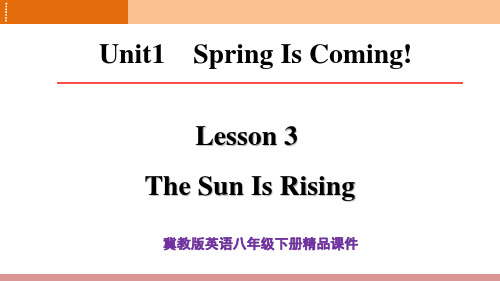
课文呈现
1) Read the song and underline the phrases that describe spring. Then listen and put the pictures in the correct order.
4
3
1
2
11
课文呈现
2) Pick a spring word. Then use each letter in the word to start a sentence.
拓展: melt 还作及物动词,意为“使软化”。
e.g. Her tears melted his heart. 她的眼泪使他心软了。
11
考点精讲
② The wind blows gently,…
考点2 wind /wɪnd/ n. 风;气流 e.g. A warm gentle wind is blowing from the east. 一阵温暖的微风自东边吹来。 There is a strong wind in Beijing. 北京的风很大。 wind 常用作 不可数名词,但可以用a+修饰词+ wind 来表示“一阵……的风”,修饰词可以是 strong, light等,说明风的强度或力量。
11
考点精讲
返回
① The snow is melting,...
温
馨
考点1 melt /melt/ v. 融化
提 示:
melt 作不及物动词,意为“融化”,常用于指冰、
可 返
雪等融化。
回 原
e.g. The ice will melt when the sun shines on it.
文
当太阳照在冰上面的时候,它就融化了。
冀教版八年级英语下册Lesson3教学设计
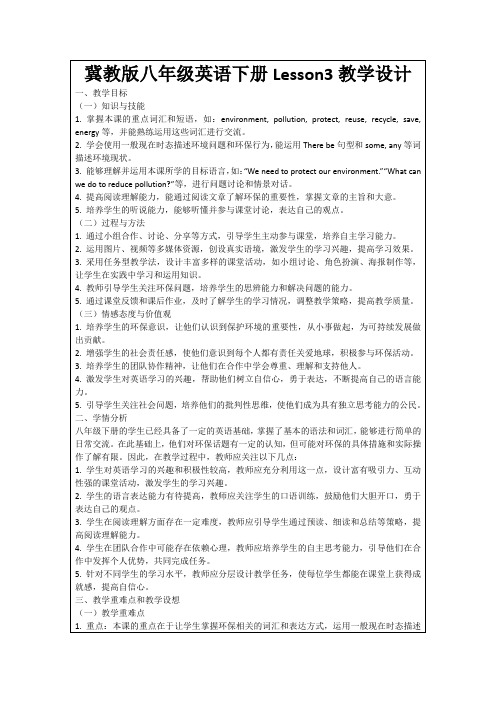
4.提高阅读理解能力,能通过阅读文章了解环保的重要性,掌握文章的主旨和大意。
5.培养学生的听说能力,能够听懂并参与课堂讨论,表达自己的观点。
-家长参与,让学生向家人介绍本课所学的环保知识,进行家庭口语实践。
3.实践作业:
-观察并记录身边的环保行为,如垃圾分类、节约用水等,撰写观察日记,分享自己的感悟。
-参与一次环保活动,如植树、清理社区环境等,拍摄照片或视频,记录实践过程。
4.预习作业:
-预习下一课的内容,提前了解新课程的主题和重点词汇,为新课的学习做好准备。
-通过总结和复述,帮助学生内化文章内容,提高他们的归纳总结能力。
3.针对听说能力的培养:
-设计听力练习,如对话、短文理解等,让学生在听的过程中,捕捉关键信息,提高听力水平。
-鼓励学生在课堂上进行角色扮演、小组讨论等活动,提高他们的口语表达能力。
-教师在课堂上给予及时反馈,纠正学生的发音错误,提高他们的语音准确性。
五、作业布置
1.书面作业:
-完成课后练习册的相关练习,巩固本课所学的词汇和语法知识。
-撰写一篇关于环保的小短文,运用一般现在时态描述身边的环境问题和环保行为,不少于80词。
-设计一份环保海报,包含本课所学的环保词汇和短语,要求图文并茂,展现环保主题。
2.口语作业:
-与同学合作,进行角色扮演,模拟一次环保主题的对话,录制视频,提高口语表达能力。
冀教版八年级英语下册Lesson3教学设计
一、教学目标
英语初二下冀教版lesson3教案
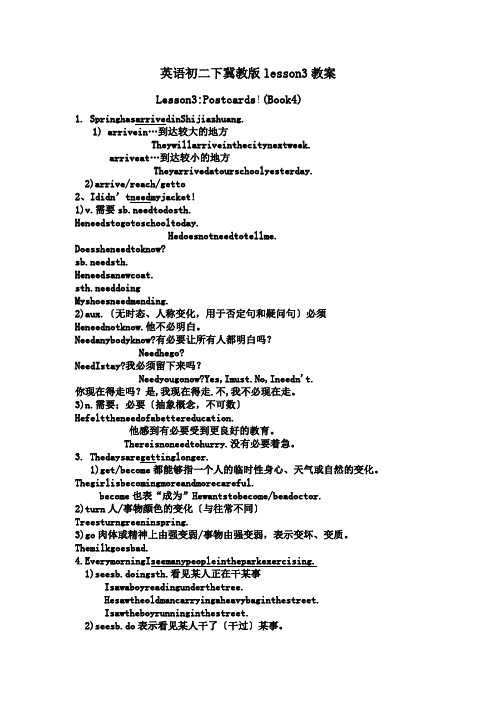
英语初二下冀教版lesson3教案Lesson3:Postcards!(Book4)1.SpringhasarrivedinShijiazhuang.1)arrivein…到达较大的地方Theywillarriveinthecitynextweek.arriveat…到达较小的地方Theyarrivedatourschoolyesterday.2)arrive/reach/getto2、Ididn’tneedmyjacket!1)v.需要sb.needtodosth.Heneedstogotoschooltoday.Hedoesnotneedtotellme. Doessheneedtoknow?sb.needsth.Heneedsanewcoat.sth.needdoingMyshoesneedmending.2)aux.〔无时态、人称变化,用于否定句和疑问句〕必须Heneednotknow.他不必明白。
Needanybodyknow?有必要让所有人都明白吗?Needhego?NeedIstay?我必须留下来吗?Needyougonow?Yes,Imust.No,Ineedn't.你现在得走吗?是,我现在得走.不,我不必现在走。
3)n.需要;必要〔抽象概念,不可数〕Hefelttheneedofabettereducation.他感到有必要受到更良好的教育。
Thereisnoneedtohurry.没有必要着急。
3.Thedaysaregettinglonger.1)get/become都能够指一个人的临时性身心、天气或自然的变化。
Thegirlisbecomingmoreandmorecareful.become也表“成为”Hewantstobecome/beadoctor.2)turn人/事物颜色的变化〔与往常不同〕Treesturngreeninspring.3)go肉体或精神上由强变弱/事物由强变弱,表示变坏、变质。
冀教版英语八年级下册_Unit5_Review_优质课课件(河北省)市优

Discuss in pairs
What’s TMhsiLsiush’soipdewa?ould raise money What could the stufdoenrt…s do…in .t!his kind of shop? Why does sheShtauvde ethnitssidweai?ll learn
C. to go C. are
ቤተ መጻሕፍቲ ባይዱ
D. becomes
√D. rush
D. were
√B. full of
B. in
C. was full of D. was filled with
C. to
D. on
B. a so
C. a such
√D. such a
√B. were trying C. going
D. were tired
Read a story
A man entered the hotel manager’s office and sat down. “I have just lost $50 and I feel very upset. I left the money in my room,” he said, “and it's not there now.” The manager was surprised and she said, “Where can your money go?” He was angry and complained, “It’s not safe in your hotel.” Just then there was a knock at the door. A girl came in with an envelope. “There is $50 in it. I found this outside this gentleman’s room” she said. “Well,” he said to the girl, “How will I leave it outside? But thanks to your honesty, I got it back!”
冀教版英语八年级下册Lesson 3 教案
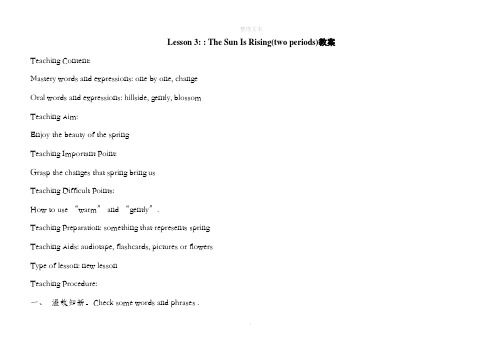
Lesson 3: : The Sun Is Rising(two periods)教案Teaching Content:Mastery words and expressions: one by one, changeOral words and expressions: hillside, gently, blossomTeaching Aim:Enjoy the beauty of the springTeaching Important Point:Grasp the changes that spring bring usTeaching Difficult Points:How to use “warm” and “gently”.Teaching Preparation: something that represents springTeaching Aids: audiotape, flashcards, pictures or flowersType of lesson: new lessonTeaching Procedure:一、温故知新。
Check some words and phrases ..二、激情导入。
Lead inFree Talk:Let the students work in three and talk about the sports that we often do in spring. Then give a talk for the class.三、新课学习。
Step 1: Showing the teaching aims on the blackboard and asking students to read them together.1.Remembering some new words and phrases of lesson 3 work in group.2.Talking about seasons.3.Understanding the dialogue meaning.Step 2:Read the song aloud as a poem. This song has this song has common English words: come with me, through the trees, one by one, the flowers blossom. Translate these expressions into English.Step3. Play the audiotape and let the students just listen with the eye closed.Step4. Play the tape again and let the students sing with it.Step5. Explain the common English expressions.Step6. Practice the song a few times, with and without the audiotape.Step7. Come to “LET’S DO IT”.四、达标训练,作业布置。
八年级下册冀教版英语第5课翻译
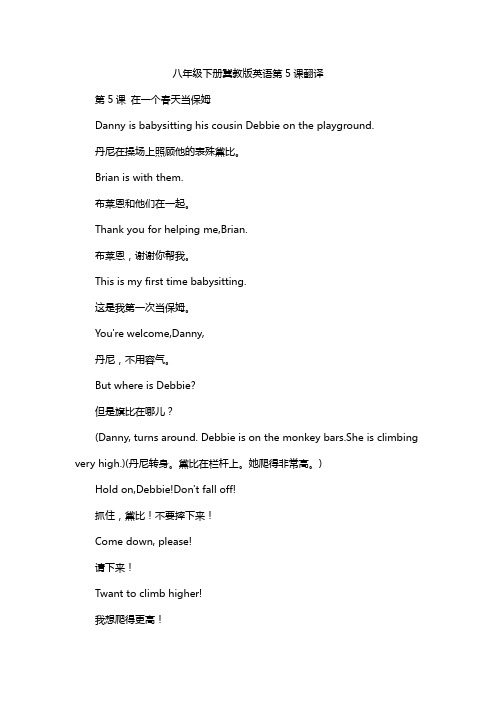
八年级下册冀教版英语第5课翻译第5课在一个春天当保姆Danny is babysitting his cousin Debbie on the playground.丹尼在操场上照顾他的表殊黛比。
Brian is with them.布莱恩和他们在一起。
Thank you for helping me,Brian.布莱恩,谢谢你帮我。
This is my first time babysitting.这是我第一次当保姆。
You're welcome,Danny,丹尼,不用容气。
But where is Debbie?但是旗比在哪儿?(Danny, turns around. Debbie is on the monkey bars.She is climbing very high.)(丹尼转身。
黛比在栏杆上。
她爬得非常高。
)Hold on,Debbie!Don't fall off!抓住,黛比!不要摔下来!Come down, please!请下来!Twant to climb higher!我想爬得更高!Come down,Debbie,黛比,下来。
You're too high up.你爬得太高了。
Let's play on the swings instead,OK?我们去荡秋干,好吗?Danny will push you.丹尼帮你推秋千。
OK, I love swings!好的,我喜欢秋千!(She climbs down,runs to the swing and cimbs on.) (她爬下来,跑向秋千并爬上去。
)Push me,Danny!Push me up higher!推我,丹尼!把我推得更高!OK.(He gives her a push.)好的。
(他推了一下。
)(She laughs.) Push harder!(她笑。
)用力推!Can I give you a push?我可以推你吗?No, I want Danny tolHigher,Danny!不,我要丹尼推!丹尼,更高点!(He is tired and hot.)(他又累又热。
最新春冀教版英语八年级下册unit 3《aimals are our friends》单元教案.doc
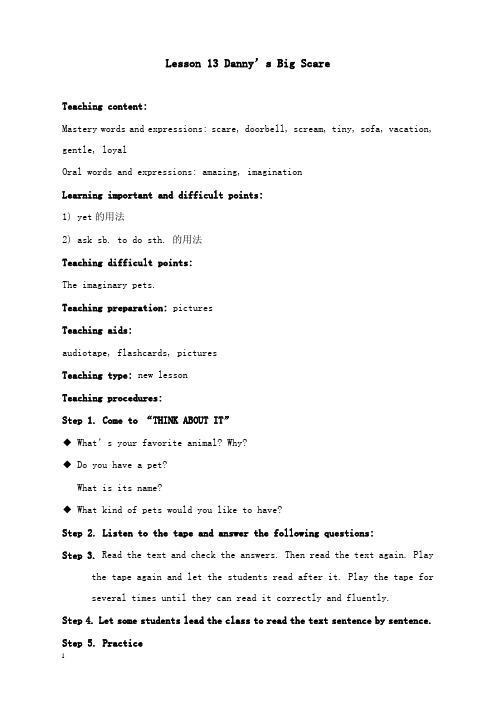
Lesson 13 Danny’s Big ScareTeaching content:Mastery words and expressions: scare, doorbell, scream, tiny, sofa, vacation, gentle, loyalOral words and expressions: amazing, imaginationLearning important and difficult points:1) yet的用法2) ask sb. to do sth. 的用法Teaching difficult points:The imaginary pets.Teaching preparation: picturesTeaching aids:audiotape, flashcards, picturesTeaching type: new lessonTeaching procedures:Step 1. Come to “THINK ABOUT IT”◆ What’s your favorite animal? Why?◆ Do you have a pet?What is its name?◆ What kind of pets would you like to have?Step 2. Listen to the tape and answer the following questions:Step 3. Read the text and check the answers. Then read the text again. Play the tape again and let the students read after it. Play the tape for several times until they can read it correctly and fluently.Step 4. Let some students lead the class to read the text sentence by sentence. Step 5. PracticeWork in pairs. Practice the similar dialogue according to the text. Step 6. Come to “PROJECT”Do you have a pet? Do many animals live with your family? Some people have dogs. Some people have cats. Some people have fish. Some people even have snakes! Do you have a pet?Step 7. Homework1. Finish off the activity book.2. Go on the next reading in the next lesson.Lesson 14 Amazing AnimalsTeaching content:Oral words and expressions:long-eared, jerboa, mouse, kiwi, lay, eggplant, shake, flap, avoidLearning important and difficult points1) remind的用法2) lay的用法Teaching preparation: picturesTeaching aids:audiotape, flashcards, picturesType of lesson: new lessonTeaching procedures:Step 1. ReviewStep 2. Come to “THINK ABOUT IT.”◆ Can you name some animals you have never seen before?◆ What animals do you think are amazing? Why?Step 3. Read the text silently and ask the students to answer the following questions:Step 4. Play the tape and let the students read after it. Pause after every line, and ask the students to repeat.Step 5. Let some students read the text in class and the others listen to see if they have any mistakes. Can they find and correct the mistakes? Step 6. Let the students rewrite the story and read it to the class.Step 7.Discuss the reading with the students. Use as much English as possible.Ask questions to make it easier for students to participate.Step 8. HomeworkWould you like to have a pet?Why or why not?Write a paragraph.Lesson 15 The Zoo Is OpenTeaching content:Mastery words and expressions: danger, dangerous, mainly, bamboo, giraffe Learning important and difficult points:1.take photos2.nearly的用法Teaching preparation: picturesType of lesson: new lessonTeaching procedures:Step 1. Show some pictures of animals to the class. Ask the students: What animals do you like best?What animals can you see in the zoo?Step 2. Come to “THINK ABOUT IT.”▲ Have you ever been to the zoo?▲ What animals do you think are dangerous? Why?▲ What rules should we obey at the zoo?Step 3. Read the text.Step 4. PracticeStep 5. Read the text in roles. The teacher walks in the classroom while they are reading. Help them if necessary.Step 6. Let some students come to the front and act the dialogue out. Step 7. HomeworkPrepare the dialogue in group of three in “Let’s Do It”, and act it the next class.Lesson 16 The Bear Escaped!Teaching content:Mastery words and expressions: escape, fierce, protect, foolLearning important and difficult points:1.escape的用法2.if的用法3.wake upTeaching preparation: picturesTeaching aids:audiotape, flashcards, picturesType of lesson: new lessonTeaching procedures:Step 1. Free talkStep 2. Come to “THINK ABOUT IT.”★ When is April Fools’ Day?★ What do people do on that day?★ Have you ever played a trick on a friend? What did you do?Step 3. Listen to the tape and answer the questionsStep 4. Read the text and check the answers. Then let the students read it loudly in class. After a while, ask the students to act it out in front of theclass.Step 5. Come to “LET’S DO IT”◆What do you think of the idea of April Fools’ Day?◆ Have you ever played a trick on someone? Share a trick with you partner.◆ What do you think “ white lie” means?Step 7. HomeworkDo you know any other interesting foreign festivals?Write them down, and share with your partner next class.Lesson 17 Save the TigersTeaching content:Mastery words and expressions: century, fur, symbol, courage, brave, chain, balance, reason, disappear, kill, cut, decreaseLearning important and difficult points:1) the number of2) balance的用法3) danger的用法Teaching preparations: picturesTeaching aids:audiotape, flashcards, picturesTeaching procedures:Step 1. ReviewStep 2. Come to “THINK ABOUT IT.”Where can you usually see a tiger?Do you think tigers need our help? Why or why not?Step 3.Listen to the tape and repeat after it. Play the tape for several until they can read it correctly and fluently.Step 4. Let some students act the dialogue out in front of the class. Step 8. HomeworkWork in groups and discuss some ways we can protect animals. Write down your ideas.Lesson 18 Friendship Between AnimalsTeaching content:Mastery words and expressions: friendship, rhino, skin, warn, insect, relationship, survive, mzee, hippo, tortoise, truly, boundaryLearning important and difficult points:1) use的用法2) warn的用法Teaching preparation: picturesTeaching aids:audiotape, flashcards, picturesType of lesson: new lessonTeaching procedures:Step 1. Come to “THINK ABOUT IT”◆Do you think there is friendship between animals?◆ What different animals have you seen living well together?Step 2. Listen to the tape and let some students retell the main idea about the text. If they can’t do well, don’t publish them. Encourage them and say: “I know it is very difficult for you. It’s also difficult for me. Let’s face the problem together.”Step 3. Read the text silently and answer the questionsStep 4. ExerciseStep 5. HomeworkWhat will you do if you go to the zoo?Do you know anything that we cannot do in the zoo? Why?Think about it, and write a short paragraph.。
冀教版八年级下册英语冀教版八年级下册英语Lesson3教案
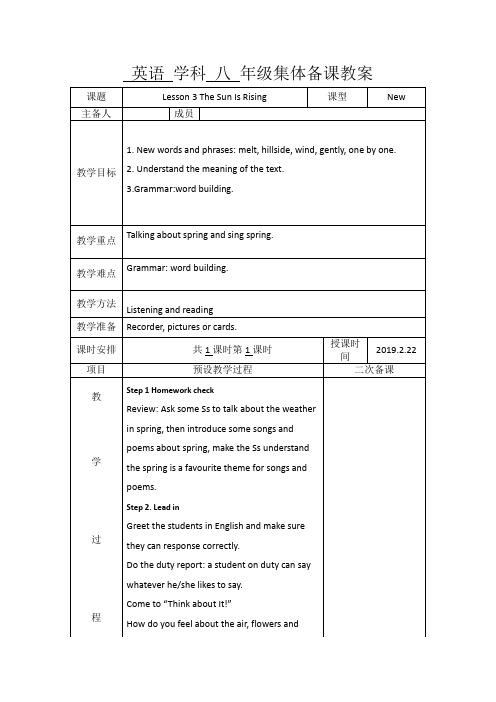
teach—teacheract—actor invent—invention
No. 6Finish “Let’s Do It!”
Step 4. Play the tape for the Ss to follow
Make the Ss listen the text, then let them read follow the tape.
英语学科八年级集体备课教案
课题
Lesson 3 The Sun Is Rising
课型
New
主备人
成员
教学目llside, wind, gently, one by one.
2. Understand the meaning of the text.
No. 5Grammar: word building.
1.Review:复合词:
Eg:thunderstorm sunrise sunset hometown
something myself nobody somebody等等
2.派生词:
Eg:rain—rainywind—windy cloud—cloudy snow—snowy
Step 5.Summary
Sum up the text what we learned,the new words,phrases,and sentences.
Sum up the grammar.
课堂作业
Finish the activity book and the practice.
Copy the new words and phrases twice.
- 1、下载文档前请自行甄别文档内容的完整性,平台不提供额外的编辑、内容补充、找答案等附加服务。
- 2、"仅部分预览"的文档,不可在线预览部分如存在完整性等问题,可反馈申请退款(可完整预览的文档不适用该条件!)。
- 3、如文档侵犯您的权益,请联系客服反馈,我们会尽快为您处理(人工客服工作时间:9:00-18:30)。
第五课时Lesson 17Save the Tigers 课时目标
一、根据句意及首字母提示写出单词。
1.A century is 100 years.
2.Red is the symbol of happiness in China.
3.Don't be afraid.Be brave and you will succeed in the end.
4.We must decrease our cost in useless production.
二、写出下列画线短语的汉语意思。
1.At_the_beginning of the 20th century,the number of tigers in the wild was around 100 000.在……之初
2.But today that number has dropped_to a few thousand.下降到;跌至
3.The tiger is at the top of the food_chain.食物链
4.It helps keep the number of other wild animals in_balance.保持平衡
5.In recent years,tigers have been in_danger of disappearing.在危险中
教学过程
环节1新课导入
教师带领学生一起复习上节课的课文内容;再通过展示两张老虎的图片进行问答。
T:Before we begin our new lesson,let's review what we have learned in lesson 16.What's the main topic of Lesson 16?
S1:...
S2:...
T:Very good! Look at the pictures.What are these?
Ss:They're tigers.
...
设计意图:通过复习上节课的内容,帮助学生巩固学过的知识,达到温故知新的效果;再通过展示老虎的图片引起学生的兴趣,引出这节课的主题。
环节2新课学习
1.让学生思考教材第42页“THINK ABOUT IT”中的两个问题,并让学生和同桌讨论,然后说出各自的想法。
2.教师请两名学生分别说出自己的想法,其他学生可集思广益,进行补充。
3.让学生欣赏课文中的图片,然后教师播放录音,学生初步了解这篇文章的内容。
4.教师指导学生画出课文中重要的单词、短语以及句子,然后进行讲解。
5.进入“Let's do it!”部分。
教师播放录音,学生根据所听内容,完成活动1的任务,教师核对答案。
6.教师再次播放录音,学生模仿语音语调小声跟读文章。
7.教师让学生再次快速浏览课文,同时要求学生独立完成活动2的任务,然后和同桌讨论表格中自己找到的信息。
教师核对答案。
8.教师把学生分成三到四人一组,围绕活动3展开讨论我们应该怎样保护动物,并整合组内成员给出的方法。
9.教师邀请每个小组代表在课堂上分享自己小组的讨论结果,教师进行点评和总结。
10.要点点拨。
(1)It helps keep the number of other wild animals in balance.
keep...in balance使……处于平衡状态,保持……的平衡。
该短语的结构为:keep+宾语+宾语补足语(介词短语),其中宾补还可以是名词、副词、形容词或动名词等。
例:We should keep the nature in balance.我们应该使自然保持平衡。
(2)For this reason,tigers are important to the environment.
①reason n.原因;动机;理由。
常用短语:for no reason无缘无故;莫名其妙。
例:That child is always crying for no reason.那个孩子总是无缘无故地哭。
②be important to 对……很重要。
例:Money is very important to me.钱对我来说非常重要。
(3)In recent years,tigers have been in danger of disappearing.
①in recent years 近几年。
它常用于现在完成时的句子中。
例:Chengdu has greatly changed in recent years.近几年来,成都发生了巨大的变化。
②in danger是固定搭配,意为“在危险中”。
其反义短语为out of danger(脱离危险)。
例:These animals are in danger.这些动物处于危险之中。
11.学以致用。
(单项选择)
(C)(1)One hundred years is a ________.
A.year B.term
C.century D.Season
(A)(2)The Great Wall is the ________ of China.
A.symbol B.flag
C.system D.nation
(D)(3)When you cross the single-log bridge(独木桥),you should keep yourself ________.
A.in danger B.in trouble
C.in fact D.in balance
(D)(4)Now a lot of animals are in ________ danger.
A.a B.an
C.the D.\[ZK)]
(A)(5)These days,people ________ many trees,so we don't have much fresh air now.
A.cut down B.come true
C.have to D.get to
设计意图:通过跟读练习,能够帮助学生掌握阅读时的语音语调;通过相关练习,帮助学生掌握阅读技巧,提高学生获取关键信息的能力;通过小组讨论怎样保护动物,可以帮助学生树立爱护动物的意识。
板书设计
请完成本课对应训练!。
